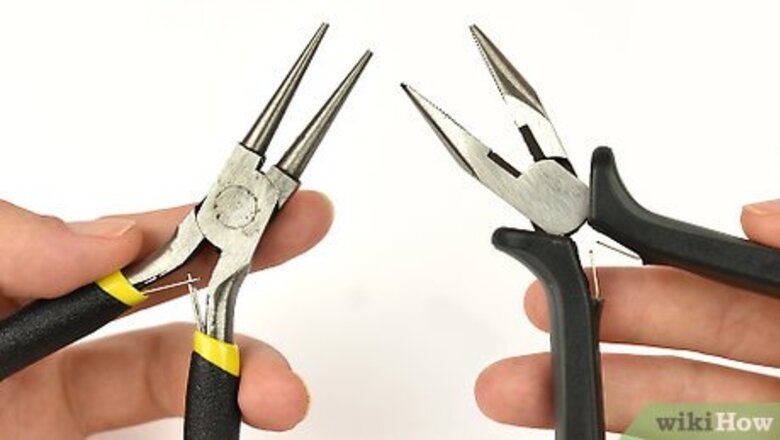
views
Using a Jump Ring and Pliers
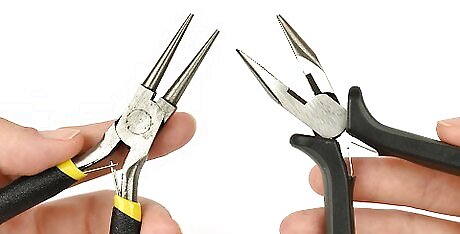
Get two sets of jewelry pliers. Round nose, chain nose, or bent nose pliers work best for this process. Both pairs don't have to be the same, and as long as they're small enough to manipulate the jump ring, they'll work fine. Needle nose pliers or strong tweezers will work in a pinch as well. Be careful not to use them too forcefully, though, to avoid leaving indentations on the ring.
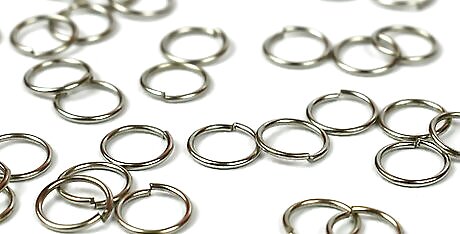
Obtain a jump ring. Since this is the standard method of attachment for bracelet charms, yours might already come attached to a jump ring. It's a small piece of wire formed into a circle with the ends touching. If not, purchase one at a local or online craft supply store. You'll usually need to buy a package of jump rings rather than just one. Jump rings are measured by diameter and gauge (the thickness of the wire). Pick a ring with the smallest diameter that will comfortably fit both the charm and your bracelet link with a bit of space for movement. A jump ring will provide an elegant, seamless-looking attachment for your charm. However, if you plan to move or switch out your charms regularly, consider a split ring or lobster clasp instead.
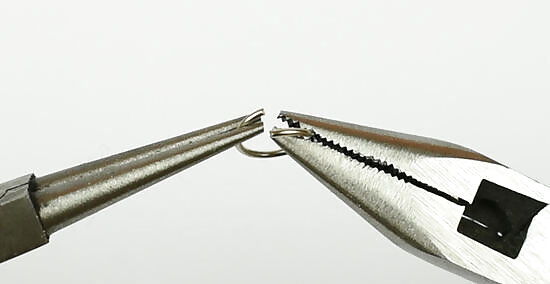
Pry the jump ring open with both pairs of pliers. Position the jump ring with the opening facing upwards and hold it in place with one pair of pliers. Take the other pair of pliers and grip onto the other side of the ring. Gently push one side away from you while pulling the other side towards you until there is a small gap between the two ends of the ring. Refrain from pulling the ends apart side-to-side. Doing this will weaken and damage the jump ring. You may not be able to close it securely, which could lead to the loss of a precious charm.
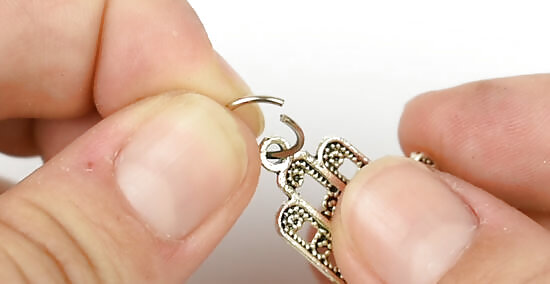
Slide the charm onto the open jump ring. Your charm should have a very small built-in loop which you can thread the jump ring through. Keeping hold of the ring with the pliers in your non-dominant hand, pick up the charm and slide it onto the ring with your dominant hand. If your charm came with a jump ring attached, you can simply leave the charm on while prying open the ring.
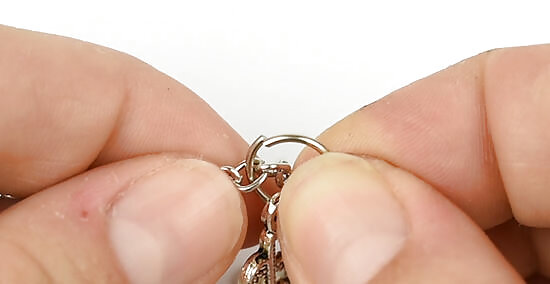
Hook the bracelet onto the open jump ring. Holding the open jump ring (with the charm attached) in one pair of pliers, pick up the bracelet and slide the desired chain link onto the jump ring. It's helpful to decide which chain link you want to place your charm on before opening the jump ring. This way, you can arrange your bracelet in the right orientation and you'll avoid accidentally dropping your charm.
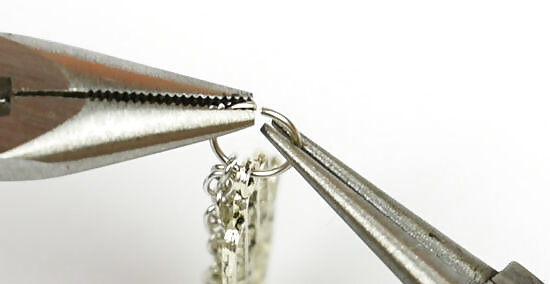
Push the jump ring closed. Using both pairs of pliers, gently push the ends of the ring back together until they meet in the middle. You'll be twisting them the opposite way that you opened them. It's safer to close the ring slowly and carefully, rather than tugging it back and forth. Over-handling may weaken or break the ring. If your charm bracelet is heavy, you can rest the bottom on a flat surface instead of dangling it in midair. This will take some strain off the jump ring you're manipulating.
Securing with a Split Ring
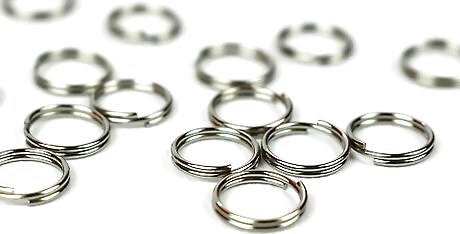
Find a split ring. Like a tiny key ring, a split ring is a coiled wire that can provide a quick and secure way to attach charms to your bracelet. If your charm doesn't already come with a split ring attached, you can buy a package of them online or from your nearest craft supplier. If your charm came with a jump ring attached, you may need to remove it before replacing it with a split ring. Pick a split ring with a diameter and gauge that are small enough to be unobtrusive, but large enough to accommodate both the charm's loop and your bracelet's link. Split rings are useful if you plan to move your charms around on occasion but still want the streamlined appearance of a circular attachment.
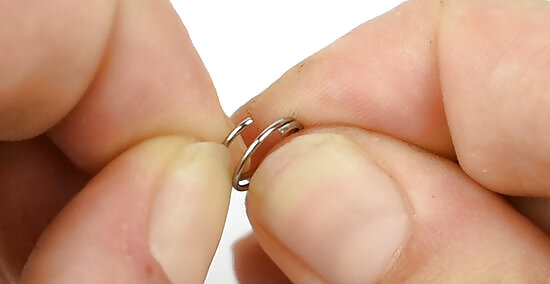
Use your fingernail to hold one end of the split ring open. Insert your fingernail beneath one end of the ring and gently pry it open. Keeping both parts of the wire parallel, open the gap until it is just wide enough to accommodate your charm loop and bracelet link. Avoid pulling the ends outward and unwinding the circular shape. This will weaken the ring and will prevent you from closing it back up securely. Split ring pliers can be used, but aren't necessary.
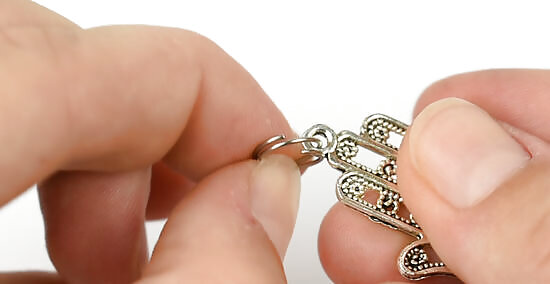
Thread the split ring onto the charm. Insert the open end of the split ring through the loop on your charm. Twist the split ring around until the charm is no longer pinched between the two sides and can move freely inside the ring – like keys on a key ring. It helps to hold the charm perpendicular to the ring, so it doesn't slip out accidentally. If your charm is already attached to the split ring, keep the charm on while creating the opening.
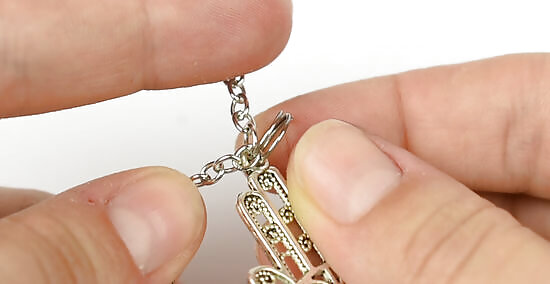
Thread the split ring onto your bracelet. While holding the split ring slightly open with your fingernail, pick up your chosen bracelet chain link in your other hand and hook it onto the split ring. Being careful not to twist the charm off, thread the split ring around the bracelet until it's completely attached. Before opening the split ring, decide which chain link on your bracelet you'll be attaching your charm to. It's helpful to decide in advance so you can make sure you have easy access to that chain link when you're preparing to pick it up.
Clipping on a Lobster Clasp

Connect the lobster clasp to your charm with a ring. Some charms come with lobster clasps already attached, making them easy to clip on and off your bracelet. If your charm doesn't have one, you can buy a package of lobster clasps at a craft store or online. You'll attach the loop on your charm to the loop on the bottom of the clasp with a small jump ring or split ring. To attach the jump or split ring, you'll follow the previous methods. The only difference is that you're connecting the lobster clasp and the charm, rather than the charm and the bracelet. Make sure you pick a lobster clasp that is large enough to grip onto your bracelet's link. If your bracelet is made of a narrow-gauge wire, you can opt for a smaller lobster clasp. However, if your bracelet is chunkier and made of thicker wire, you'll want a larger lobster clasp. You may either connect the two pieces with a jump ring and two pairs of pliers, or you can thread them both onto a split ring.

Press down on the latch to open the clasp. Hold the base of the clasp in one hand and press down on the latch with the forefinger on your other hand. It's easiest to use your dominant hand for pressing down the latch. If you're used to opening lobster clasps regularly on necklaces and bracelets, you can probably do this with one hand. Press down on the latch with your forefinger and support the bottom of the clasp with your thumb.
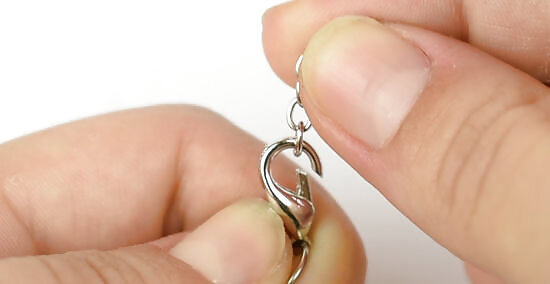
Clip the clasp onto the bracelet link. Locate the chain link of your choice before you get your clasp ready to attach. Then, pick up your bracelet at that point and slip the chain link into the open clasp. Let go of the latch and it will close completely. Keep in mind that lobster clasps are easy to accidentally open. The latch might get caught on a piece of clothing, or if it gets stuck in the open position, your charm might fall off without you noticing. Lobster clasps are a less secure method of attachment, but if you're looking for a safe long-term solution, try a jump ring or split ring instead.















Comments
0 comment